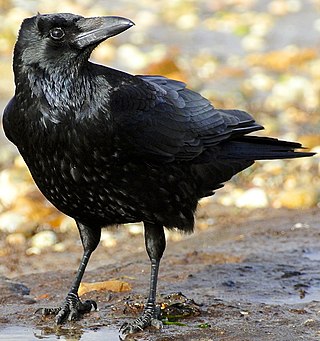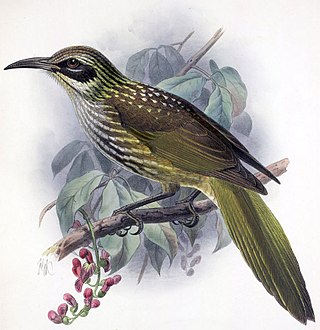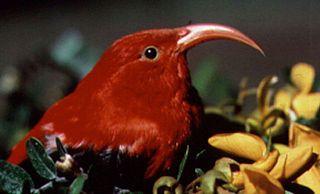
The nene, also known as the nēnē or the Hawaiian goose, is a species of bird endemic to the Hawaiian Islands. The nene is exclusively found in the wild on the islands of Oahu, Maui, Kauaʻi, Molokai, and Hawaiʻi. In 1957, it was designated as the official state bird of the state of Hawaiʻi.

The Hawaiian crow or ʻalalā is a species of bird in the crow family, Corvidae, that is currently extinct in the wild, though reintroduction programs are underway. It is about the size of the carrion crow at 48–50 cm (19–20 in) in length, but with more rounded wings and a much thicker bill. It has soft, brownish-black plumage and long, bristly throat feathers; the feet, legs, and bill are black. Today, the Hawaiian crow is considered the most endangered of the family Corvidae. They are recorded to have lived up to 18 years in the wild, and 28 years in captivity. Some Native Hawaiians consider the Hawaiian crow an ʻaumakua.

A crow is a bird of the genus Corvus, or more broadly, a synonym for all of Corvus. The word "crow" is used as part of the common name of many species. The related term "raven" is not linked scientifically to any certain trait but is rather a general grouping for larger-sized species of Corvus.

The Kauaʻi ʻōʻō or ʻōʻōʻāʻā was the last member of the ʻōʻō (Moho) genus within the Mohoidae family of birds from the islands of Hawaiʻi. The entire family is now extinct. It was previously regarded as a member of the Australo-Pacific honeyeaters.
The ʻāmaui or Oahu thrush was a subspecies of the olomaʻo endemic to the island of Oahu. It was the first member of its genus to become extinct, c. 1850. Some taxonomic authorities consider it a distinct species, but the International Ornithological Congress presently classifies it as a subspecies of M. lanaiensis.

The kioea was an endemic Hawaiian bird that became extinct around the mid-19th century.

The Hawaiʻi ʻōʻō is a member of the extinct genus of the ʻōʻōs (Moho) within the extinct family Mohoidae. It was previously regarded as member of the Australo-Pacific honeyeaters (Meliphagidae).

The Kauai ʻakialoa was a Hawaiian honeycreeper in the subfamily Carduelinae of the family Fringillidae. It was endemic to the island of Kauai, Hawaii. It became extinct in the 20th century due to introduced avian disease and habitat loss. The Kauai ʻakialoa was about seven and a half inches in length and had a very long downcurved bill, which covered one third of its length. The adult males were bright olive-yellow on top and yellow on the bottom. The throat, breast, and sides of the body were olive-yellow. The females, however, were green-gray above and had a shorter bill.

Achatinella apexfulva is an extinct species of colorful, tropical, arboreal pulmonate land snail in the family Achatinellidae, once present on Oahu, Hawaii. A. apexfulva is the type species of the genus Achatinella. The specific name, apexfulva, meaning "yellow-tipped", refers to the yellow tip of the snail's shell. Inspired from the taxon, the species has been given common names such as yellow-tipped Oʻahu tree snail or Hawaiian yellow-tipped tree snail. Officially, it is listed as ‘critically endangered’ by the IUCN, however, this is because its conservation status has not been updated in 28 years.
The highland finch is an extinct member of the Fringillidae and a Hawaiian honeycreeper which is known only from a few bones found in caves. It is the only member of the genus Orthiospiza. It was endemic to the high-elevation areas of Mount Haleakalā on the Hawaiian island of Maui. It has been speculated that they were pushed to extinction because of habitat loss. It is known only from fossil remains and likely became extinct before the first Europeans arrived in 1778.
The Kauai finch is an extinct bird in the genus Telespiza of the family Fringillidae. It was endemic to the Hawaiian islands of Kauai and Oahu. It is only known from fossil remains and likely became extinct before the first Europeans visited Hawaii in 1778.
The primitive koa finch is an extinct species of Hawaiian honeycreeper in the subfamily Carduelinae of the family Fringillidae. It is known from fossils on the islands of Maui and Oʻahu in Hawaii.

The great Oʻahu rail or great Oʻahu crake is a little-known extinct bird species from Oʻahu, Hawaiʻi, attested only by a few subfossil bones. The holotype is a right tarsometatarsus found in a flooded sinkhole on the ʻEwa Plain near Barbers Point, the southwestern tip of Oʻahu.

Hawaiian honeycreepers are a group of small birds endemic to Hawaiʻi. They are members of the finch family Fringillidae, closely related to the rosefinches (Carpodacus), but many species have evolved features unlike those present in any other finch. Their great morphological diversity is the result of adaptive radiation in an insular environment. Many have been driven to extinction since the first humans arrived in Hawaii, with extinctions increasing over the last two centuries following European discovery of the islands, with habitat destruction and especially invasive species being the main causes.

The Oʻahu ʻelepaio is a monarch flycatcher found on the Hawaiian Island of Oahu.

Thambetochen is an extinct genus of moa-nalo duck. It contains two species, the Maui Nui moa-nalo and the smaller O'ahu moa-nalo.

The Hawaiian stilt is an endangered Hawaiian subspecies of the black-necked stilt species. It is a long-legged, slender shorebird with a long, thin beak. Other common names include the Hawaiian black-necked stilt, the aeʻo, the kukuluaeʻo, or it may be referred to as the Hawaiian subspecies of the black-necked stilt.

The robust crow or slender-billed crow was a species of large, raven-sized crow that was endemic to the islands of Oahu and Molokai in the Hawaiian Islands during the Holocene. C. viriosus was frugivorous and was adapted for this with a long, slender bill. It was pushed to extinction due to the arrival of people and pests like rats.















